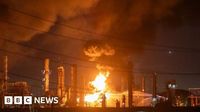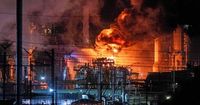On the night of October 2, 2025, a massive fire erupted at Chevron’s sprawling oil refinery in El Segundo, California, startling residents, lighting up the night sky for miles, and prompting an immediate and coordinated emergency response. The incident, which began around 9:30 p.m., sent a towering fireball and plumes of smoke into the air, visible as far away as downtown Los Angeles, roughly 20 miles to the north. For many in the area, the event was nothing short of terrifying.
"Pretty much the whole sky was orange," recalled Sam Daugherty, a resident who lives just ten blocks away from the refinery, in an interview with KABC-TV. He described the panic and confusion that swept through his neighborhood: "I began packing a bag in a panic." Others, like Mark Rogers, told the Los Angeles Times that the explosion was so intense, "I thought we got nuked or something." Keith Mohr, another local, added, "I didn’t know if a plane crashed or there was an earthquake or both." The sense of shock was palpable, with some residents comparing the rumble and the sudden burst of flames to an earthquake or a plane crash.
The Chevron El Segundo refinery, the largest oil-producing facility on the West Coast, sits just a mile south of Los Angeles International Airport. Covering roughly 1,000 acres and boasting over 1,100 miles of pipelines, the facility is a linchpin in California’s energy infrastructure. According to company data cited by Reuters and NBC Los Angeles, the refinery can process up to 290,000 barrels of crude oil per day, supplying about 20% of all motor vehicle fuels and 40% of the jet fuel consumed in Southern California. It’s no exaggeration to say that this refinery keeps a significant portion of the region’s economy running.
As the fire raged, officials in El Segundo and neighboring Manhattan Beach moved quickly to protect the public. Residents were urged to stay indoors, windows and doors were to remain closed, and those with HEPA air purifiers were encouraged to use them if smoke or elevated air pollution was detected. A shelter-in-place order was issued for parts of Manhattan Beach but was lifted shortly after 1 a.m. the following morning, according to emergency notifications from the city. Despite the dramatic scene, there were no evacuation orders for El Segundo or the broader area. The City of El Segundo confirmed via social media, "All roads have been reopened after last night’s Chevron fire." Pacific Coast Highway, which had been closed temporarily, was also reopened by Friday morning.
Chevron, for its part, emphasized the effectiveness of its emergency response. In a statement, the company said, "Following Chevron’s active response along with support from the cities of El Segundo and Manhattan Beach emergency services, the fire is now out." The company further stressed that all refinery personnel and contractors were accounted for and that there were no injuries. "No evacuation orders for area residents have been put in place by emergency response agencies monitoring the incident, and no exceedances have been detected by the facilities fence line monitoring system," Chevron stated. The fire was described as "isolated" and confined to a processing unit at the southeast corner of the refinery.
Firefighters from Chevron’s own fire department, as well as teams from El Segundo and Manhattan Beach, responded immediately to the scene. El Segundo Mayor Chris Pimentel explained to reporters, "Our station is about a .25 mile away from the gates of Chevron. Obviously, we are very concerned, and there is a lot of investigative work to be done to see what has happened." By early Friday, the fire was fully extinguished, though the cause remained under investigation. Chevron announced it had launched an internal review to determine what sparked the blaze.
Helicopter footage from NBC Los Angeles captured the intensity of the event, showing flames shooting from two stacks and another area of the refinery. Residents, like Howard Thorne, described the surreal scene: "I never, ever fear anything. This — I got in panic mode when I saw it. I was literally in panic mode." Another local, Keith Moore, who lives just south of the refinery in Manhattan Beach, said, "The whole sky was lit up. It was like a really, really – brighter than the moon on a really bright day." He and his family decided to pack up their dogs and leave, just to be safe.
Throughout the ordeal, air quality was a major concern. The South Coast Air Quality Management District detected elevated levels of volatile organic compounds overnight at the refinery and in community monitors. However, by Friday morning, local air quality was reported as "good" in El Segundo, with most monitors showing no significant pollution. The agency cautioned that the situation could change as onshore winds strengthened later in the day, advising residents to remain vigilant and check real-time air quality updates. "The situation is evolving, and we continue to monitor it closely," the agency said in a statement.
California Governor Gavin Newsom and Los Angeles Mayor Karen Bass were both briefed as the crisis unfolded. Newsom’s office announced, "Our office is coordinating in real time with local and state agencies to protect the surrounding community and ensure public safety." Mayor Bass reassured the public that there was no known impact to Los Angeles International Airport, and flights continued to operate normally. "LAFD stands at the ready to assist with any mutual aid request," she posted on X.
The Chevron El Segundo refinery has a long history, having been in operation since 1911. It has weathered several serious incidents over the past decade, including fires in 2017 and 2022. In 2012, Chevron faced a nearly $1 million fine for a major fire at its refinery in the San Francisco Bay Area. The recent event serves as a reminder of the risks inherent in operating such large-scale facilities, even as they remain critical to the region’s energy supply.
By the morning of October 3, 2025, the immediate danger had passed. There were no injuries, no evacuations, and the air quality remained largely unaffected. Still, questions linger about what caused the fire and what steps will be taken to prevent a recurrence. For now, Chevron’s investigation is underway, state and local officials remain on alert, and residents—many of whom experienced a night they’ll never forget—are left to reflect on the fine balance between industrial progress and public safety.

